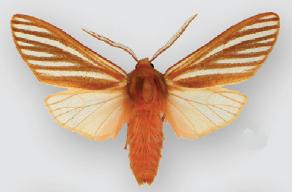
The Arctiini are a tribe of tiger moths in the family Erebidae.

Halysidota tessellaris, also called the pale tiger moth, banded tussock moth, and tessellated halisidota, is in the family Erebidae and the tribe Arctiini, the tiger moths. The species was first described by James Edward Smith in 1797. Like many related species, adult moths have chemical defenses acquired from its host plants, in this case, alkaloids. Larval behaviors suggest that they are chemically protected; they have not been analyzed for alkaloid content.

Agaraea is a genus of tiger moths in the family Erebidae. The genus was erected by Gottlieb August Wilhelm Herrich-Schäffer in 1855.

Amastus is a genus of moths in the family Erebidae. The genus was erected by Francis Walker in 1855.

Chrostosoma is a genus of moths in the subfamily Arctiinae. The genus was erected by Jacob Hübner in 1819.

Halysidota is a genus of moths in the family Erebidae. The genus was erected by Jacob Hübner in 1819.

Leucanopsis is a genus of moths in the family Erebidae. The genus was described by Alfredo Rei do Régo Barros in 1956.

Lophocampa is a genus of moths in the family Erebidae. The genus was erected by Thaddeus William Harris in 1841. It contains around 75 species.

Pseudohemihyalea is a genus of moths in the family Erebidae described by Régo Barros in 1956. While the caterpillars of most species of Pseudohemihyalea feed on broad-leaved trees, the P. ambigua group has larvae that feed on conifers. Their forewing coloration has accordingly evolved to light-and-dark lengthwise striping, giving better camouflage among the slim needles of the host plants. In this, they seem to be convergent to certain geometer moths, such as Caripeta piniata or Sabulodes niveostriata.

Selenarctia is a genus of moths in the family Erebidae.

Halysidota harrisii, the sycamore tussock moth, is a moth of the family Erebidae and the tribe Arctiini, the tiger moths. The species was first described by Benjamin Dann Walsh in 1864. It is found in southeastern Canada, the eastern parts of the United States, and northeastern Mexico.
Halysidota baritioides is a moth of the family Erebidae. Described by Walter Rothschild in 1909, it is found in Brazil.
Halysidota brasiliensis is a moth of the family Erebidae. It was described by Walter Rothschild in 1909. It is found in Paraguay and the south-eastern Brazilian states of Bahia, São Paulo, Paraná, Rio de Janeiro and Rio Grande do Sul.
Halysidota fuliginosa is a moth of the family Erebidae. It was described by Walter Rothschild in 1909. It is found in Mexico, Guatemala, Honduras, Costa Rica, El Salvador and possibly Peru and Venezuela.
Halysidota insularis is a moth of the family Erebidae. It was described by Walter Rothschild in 1909. It is found on Saint Lucia.
Halysidota intensa is a moth of the family Erebidae. It was described by Walter Rothschild in 1909. It is found in Guatemala, Costa Rica, Honduras, Colombia, Venezuela, Ecuador, Peru and Bolivia.
Halysidota meridionalis is a moth of the family Erebidae. It was described by Walter Rothschild in 1909. It is found in Mexico.

Halysidota orientalis is a moth of the family Erebidae. It was described by Walter Rothschild in 1909. It is found in Mexico, Guatemala, Costa Rica, Panama, the Antilles, Colombia, Venezuela, Ecuador, Peru, Bolivia, French Guiana, Brazil and possibly Chile.
Halysidota steinbachi is a moth of the family Erebidae. It was described by Walter Rothschild in 1909. It is found in Argentina, Bolivia and Brazil.
Halysidota underwoodi, or Underwood's tussock moth, is a moth of the family Erebidae. It was described by Walter Rothschild in 1909. It is found in Mexico, Guatemala, Nicaragua, Costa Rica, Panama, Colombia, Venezuela, Ecuador, Peru and Bolivia.








